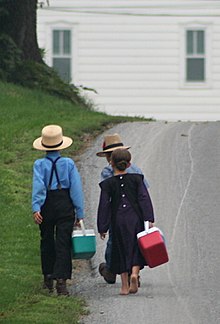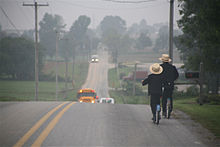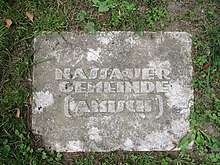Amish
The Amish (English Amish ['ɑːmɪʃ]) are an Anabaptist Protestant denomination. The name is derived from the name of their founder Jakob Ammann (1644-1730). The Amish have their roots in the Reformation Anabaptist movement of central Europe, especially Switzerland and southern Germany. The Amish separated from the mainstream of the Anabaptists, the Mennonites, in 1693.
When people speak of the Amish today, they almost always mean the "Old Order Amish". This is because in the second half of the 19th century, the Amish split into various subgroups, of which the Old Order Amish made up only about a third. Most of the other subgroups, however, lost their Amish characteristics over time and assimilated into American society. In addition to the Old Order Amish, however, the Kauffman Amish Mennonites, the Beachy Amish, and the New Order Amish have retained portions of the old Amish culture. The Conservative Mennonites, many of whom are Amish in origin, have preserved traditions that are both Mennonite and Amish. The Old Order Amish are now divided into more than forty subgroups, some of which differ considerably.
Old Order Amish lead a life strongly rooted in agriculture and are known to reject certain modern techniques, adopting innovations only after careful consideration of the implications. The Amish place great value on a family with clearly defined gender roles, community, and seclusion from the outside world. Like other Anabaptist churches, the Amish practice confessional baptism exclusively and, in keeping with the Sermon on the Mount, reject violence and the swearing of oaths.
The Amish are predominantly descended from southwestern Germans or German-speaking Swiss and speak mostly Pennsylvanian German among themselves, with smaller subgroups speaking an Alsatian or a Bernese German dialect instead. As of 2015, there were about 300,000 Amish living in 32 states in the United States, as well as in Ontario, Canada, in about 500 settlements and 2,200 community districts.
In recent decades, the Amish have become a popular subject of popular culture, with the mass media in particular painting a picture of the Amish that often deviates greatly from reality. The best example of a highly distorted portrayal of the Amish is the television series Amish Mafia.

Children of an Amish community on their way to school (2006)
Names
The name "Amish" developed from the surname of Jakob Ammann from Erlenbach im Simmental, who was the elder (community leader) of a Mennonite community in Alsace and separated from the main branch of the Mennonites in 1693 with like-minded people.
In English, the Amish are referred to as Amish, with the "A" pronounced like the German A.
History
Emergence of the Anabaptists
→ Main article: Anabaptist
The prehistory of the Amish is anchored in the Reformation period. In addition to the well-known reformer Martin Luther, there were others, such as Ulrich Zwingli, in whose environment the Anabaptist movement arose in Zurich. Luther's rebellion against the papacy provided the initial spark for other people to also actively work for church reform. Thus, the reformers Thomas Müntzer, Ulrich Zwingli and the somewhat later John Calvin are to be mentioned as well as the radical-reformational Anabaptist movement (disparagingly also called "Anabaptists") with its own reformers such as Felix Manz, Konrad Grebel or Menno Simons.
In the course of time, the Anabaptist movement gave rise to the evangelical religious community of the Mennonites, which in the 17th century also included the congregations that called themselves Swiss Brethren in Switzerland as the remnants of the persecuted Anabaptists. These had accepted the Dordrecht Confession of the Mennonites of the Netherlands and northern Germany in 1632, but did not practice as strictly the separation from the world and congregational banishment demanded there in the case of disobedience after violations of the order.
Origin of the Amish
At the end of the 17th century, the strict application of the Dordrecht Confession by the Mennonite elder Jakob Ammann caused unrest in the Swiss and nearby Alsatian congregations, whereby the stronger contact of the Alsatian Mennonites with the Netherlands and the similarity of conditions in both areas, namely a relatively large tolerance on the part of the state, played a role. The main opponent in this dispute was the Swiss Mennonite elder Hans Reist, with whom Ammann also argued over the question of who could be saved, that is, who would go to heaven.
In Switzerland at that time, many non-Mennonites helped persecuted Mennonites by hiding them or giving them other help, thereby saving their lives. Hans Reist believed that these so-called "faithful-hearted" people could also be saved even though they did not join the "church of God"; their own church was understood to be the only real church. Many of these "faithful-hearted" were also very close to the Mennonite doctrines, but circumstances prevented many from joining them, such as fear of losing their lives.
Ammann saw this much more rigorously: he demanded a complete conversion to Mennonitism with all its consequences. The true believers should "take up the cross like the example" and would then have a "living hope of salvation," while doubters and undecideds who "love this world even more than the Lord after all" could not expect grace. This was one of the main points of contention.
Based on the Dortrechter Confession of 1632 and the Bible, which speaks of a humble way of life, Ammann also demanded a strict handling of congregational discipline and the observance of certain rules about the clothing and beard of the believers. As a result, many strict elements were actually implemented in the newly forming group.
All these points of contention ended in a split. The "Ammann people", the community of Ammanns, came into being. The division started with Ammann: Whoever disagreed with Ammann, he banished and demanded that the community break off contact with him (shunning). This also applied within the family: from then on, husband and wife had to abstain from their marital sex life and were not allowed to eat at the same table.
Later Jakob Ammann saw that his way of proceeding was too rigid and banished himself as punishment. However, by this time the split was already too entrenched to be reversed. Thus, from 1693 on, there were two separate formations of the Swiss Brethren or Mennonites in southern Germany, Alsace and Switzerland.
Distribution in Europe in the 18th and 19th centuries
In addition to Switzerland, a considerable number of Amish lived in Alsace in the early 17th century, where there was much greater religious tolerance than in Switzerland. This area gradually came under French control from 1648. Louis XIV, the King of France, did not tolerate any other confessions besides the Roman Catholic Church, so that a part of the Amish emigrated from Alsace, which had become French, to the imperial German territories of Mömpelgard, Lorraine, Saarland and Bavaria, as well as to a large extent to the Palatinate, where Mennonites had been living since 1688, who became Amish after 1693.
First wave of emigration to America
As early as 1683, German-speaking Mennonites from Krefeld had founded a settlement in Pennsylvania called Germantown (Deitscheschteddel). In 1709 a wave of emigration of Palatines to North America began, which only ended with the French Revolution. With this wave from the Palatinate, about 500 Amish, or about 100 families, came to Pennsylvania, where a distinct German culture with its own Palatine-influenced dialect emerged, the culture of the Pennsylvania Germans, called "Pennsylvania Dutch" in English. The first of these Amish immigrants to be documented arrived in Philadelphia in 1737 on the ship Charming Nancy. The Amish found more favorable conditions in Pennsylvania, where the Quaker William Penn guaranteed freedom of worship, than in Europe, where religious freedom was not essentially established until the 19th century.
Second wave of emigration to America
A second wave of emigration began in 1815, after the turmoil of the Napoleonic Wars had subsided, and continued until World War I. After 1860, however, very few Amish came to America, so the end of this wave is often placed around 1860. The immigrants of this second wave no longer came only from the Palatinate, but also from Switzerland and Alsace and the areas mentioned above. Because it was not uncommon for almost complete congregations to emigrate, the remaining congregations that were left behind not infrequently dissolved, for example in Hesse and Bavaria.
Origin of the Old Order Amish
Between the years 1862 and 1878, so-called servant meetings, that is, gatherings of Amish community leaders to discuss issues of modernization and to preserve Amish unity, occurred in North America. These assemblies failed in 1865, however, in that no compromise could be found with the traditionalists, so they withdrew from the assemblies and organized themselves as "Old Order Amish" for the next several decades. The Modernizers, on the other hand, who made up about two-thirds of the Amish and called themselves "Amish Mennonites," moved increasingly in the direction of the American majority society and, especially in the first third of the 20th century, united with the Mennonites after they had gradually lost all Amish distinctiveness.
The process of division was a slow process of sorting and it took about 50 years for all the Amish to distribute themselves among the various Amish groups according to their attitudes.
In the course of this process, other Amish subgroups emerged, for example the Egli Amish and the Stuckey Amish, who also eventually assimilated completely, as well as the Kauffman Amish, who followed the "sleeper preacher" John D. Kauffman (1847-1913) and are the only ones of the Amish modernizers to have largely retained their Amish culture. A middle group between modernizers and traditionalists slowly developed into very conservative Mennonites who are only partially assimilated. These formed the Conservative Amish Mennonite Conference in 1910, which dropped the word "Amish" from its name in 1957.
Most of the 19th-century immigrants joined the Modernizers; only a few from Switzerland and Alsace became Old Order Amish. Among these few are the Amish in Adams and Allen Counties in Indiana with their daughter settlements who still speak Swiss and Alsatian dialects, respectively. These so-called "Swiss Amish," who speak dialects of their old homeland rather than Pennsylvania German, constitute about seven percent of the Amish today.
In Europe, no corresponding division took place with the departure of the traditionalists. Here all Amish congregations moved toward the majority society and sooner or later joined the local Mennonites or became Mennonite congregations. The last Amish congregation in Germany existed in Ixheim until 1937, and the last one in Europe was in Luxembourg until 1941. Both congregations eventually joined Mennonite congregations as well.
North America today
The two largest Amish settlements today are in LancasterCounty, Pennsylvania, and a multi-county settlement in Holmes County, Wayne County, Tuscarawas County, and Stark County, Ohio. The third largest Amish settlement is in Elkhart and LaGrange Counties in Indiana, and the fourth largest settlement is in Geauga County, in Ohio. Amish are now found in over thirty U.S. states and in the Canadian provinces of Ontario, Manitoba, and Prince Edward Island. Outside North America, there have been attempts to form settlements in Central America and in Paraguay, but these have usually not been long-lasting.
The Amish do not live in closed settlements or villages. While there are areas where there are many Amish and where they dominate the landscape, they almost always live next to "English" neighbors.
In the settlements it is generally noticeable that certain surnames predominate. This suggests that whole clans with their name bearers moved out from the first settlements. Thus, their gene pool has also migrated with them. In Lancaster County, for example, the name Stoltzfus (alternate spelling: Stoltzfoos) predominates 25 percent of the time, then come the names Byler, Fisher, Petersheim, Lapp, and King. In LaGrange, Indiana, Borntrager, Miller, and Schrock predominate, and in the Swiss German settlements in Allen County, Adams County, Indiana, the surnames Graber, Grabill/Kraybill, or Schwartz.

Amish in Pennsylvania often use pedal scooters instead of bicycles

In a horse-drawn carriage (buggy)

Memorial stone of the former Amish community in Nassau at the Mennokate
Search within the encyclopedia